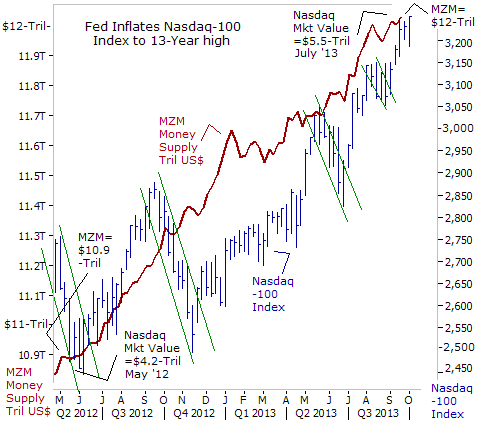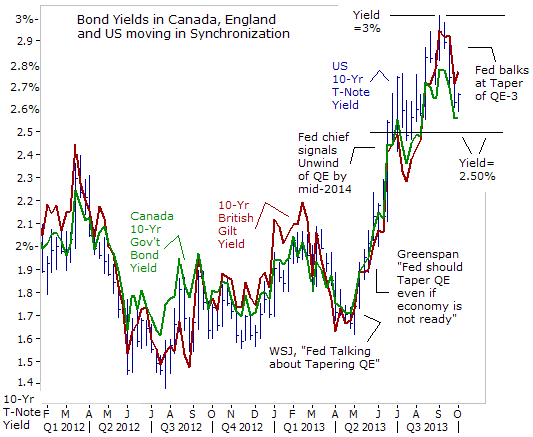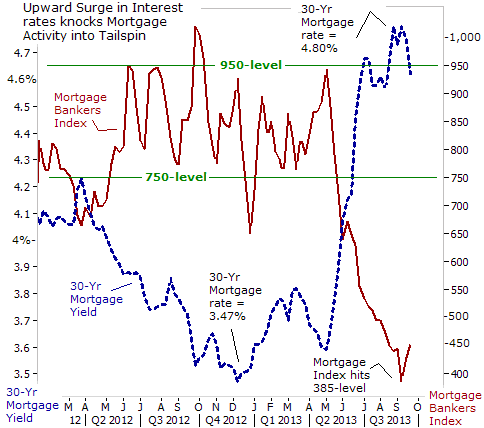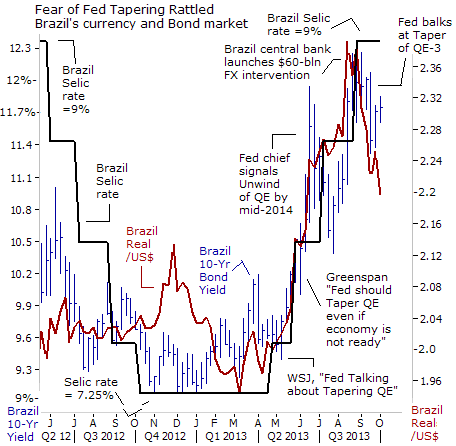Fed Retreats From QE Tapering, Five Reasons Why
Interest-Rates / Quantitative Easing Oct 03, 2013 - 06:36 PM GMTBy: Gary_Dorsch
 Nowadays, the sitting members of the inner circle at the Federal Reserve are nothing more than political lackeys - conducting the nation's monetary policy, at the beset of whatever political party happens to hold the upper hand in the legislature. In his May 29th speech, titled "Central banking at a Crossroads," former Fed chief Paul Volcker lamented that the Fed had been hijacked by the Treasury and the White House. In calling for the Bernanke Fed to begin rolling back QE-3, Volcker said, " There is something else beyond the necessary mechanics and timely action that is at stake. The credibility of the Federal Reserve, its commitment to maintain price stability and its ability to stand up against pressing and partisan political pressures is critical. Independence can't just be a slogan," he warned.
Nowadays, the sitting members of the inner circle at the Federal Reserve are nothing more than political lackeys - conducting the nation's monetary policy, at the beset of whatever political party happens to hold the upper hand in the legislature. In his May 29th speech, titled "Central banking at a Crossroads," former Fed chief Paul Volcker lamented that the Fed had been hijacked by the Treasury and the White House. In calling for the Bernanke Fed to begin rolling back QE-3, Volcker said, " There is something else beyond the necessary mechanics and timely action that is at stake. The credibility of the Federal Reserve, its commitment to maintain price stability and its ability to stand up against pressing and partisan political pressures is critical. Independence can't just be a slogan," he warned.
Today's reality is however, the Fed has become the "fourth branch of the US-government." Acting in strict secrecy, the Fed determines "target rates" for unemployment and inflation, manipulates interest rates, grows the money supply, rigs the value of the stock market, and regulates the nation's banks. And there is no longer any pretense of an allegiance to "Moral Hazard." Congress and the American people are left in the dark. Nowadays, the ruling leaders of the Democratic Party are utterly opposed to auditing the Fed , because they realize the central bank is the goose that lays the golden eggs. The Fed is buying $45-billion of US Treasury notes each month, and thereby financing the US welfare state, at low interest rates.
Whoever the President picks to run the Fed should be expected act in accordance with the wishes of the White House and the Treasury. On Oct 1st, US President Barack Obama told NPR News, "Ben Bernanke's done an outstanding job. He's maintained confidence. And whoever I appoint will continue many of the smart policies that Ben Bernanke's made." The code words "maintaining confidence," refers to the Fed's ability to keep the "Least Loved Stock market Rally" climbing higher along an upward trajectory, even amid anemic economic growth.
Bernanke has engineered the fourth biggest Bull market in Wall Street's history. There've been pullbacks and short-lived corrections along the way, but the Fed has always kept its foot pressed firmly on the monetary accelerator, and thereby keeps the speculative juices flowing. Over the past 1-½ years, the Fed has increased the high octane MZM money supply by +10% to an all-time high of $12-trillion. In turn, traders have bid-up the combined value of NYSE and Nasdaq listed stocks to a record $22-trillion. That's great news for the Richest-10% of Americans that own 80% of the shares on the stock exchanges.
(1) Financial Suppression - As for Bernanke's successor, - the only qualification is a readiness to monetize the Treasury's debt, and to funnel even more money into the financial markets, through its clandestine activities. The CBO has warned the ruling political class and the Fed that if Treasury yields move back to their averages in the 1990's, it's a scenario that would add $1.44-trillion in interest costs over 10-years. Thus, the first reason the Fed balked at Tapering QE, it needs to keep the cost of financing Washington's debt as low as possible.
However, the higher the stock market climbs, - the greater the chance of a sharp correction along the way. On October 2nd, the US Treasury chief Jacob Lew and President Obama with the key members of the "Plunge Protection Team" (PPT), at the White House, in an effort to plot future strategies on how to deal with any possible shakeouts in the stock market, when Bearish news arrives. The meeting included the elite of the financial aristocracy, - the CEO's of JP-Morgan Chase, Goldman Sachs, Citigroup, Deutsche Bank, and Bank of America , Morgan Stanley, and Wells Fargo . The PPT aims to have a rescue plan in place, if upcoming negotiations over the debt ceiling with the House Republicans get deadlocked.

Still, the wealth that's building up on Wall Street is not "trickling down" to the struggling masses on Main Street. Pushing up equity and home prices is mostly benefiting the wealthiest of Americans . The Fed's own Survey of Consumer Finances in 2010, the last year for which data are available, explains why. It shows that the Top-10% of US-income earners had financial assets totaling $550,800, or 20-times the holdings ($27,550) of the other 90 percent . The Top-10% of the wealthiest Americans own 80% of the shares listed on the NYSE and Nasdaq, while the median equity holdings of the rest of the population was only $17,700, hardly enough to make a difference in one's lifetime. That's because half of the US-citizenry owns no equities at all and can't participate in the Fed's easy money give-away.
Thanks to QE, wealth inequality in America is at its widest since the 1920's, in both relative and absolute terms. Last year, the real median household income in America was $51,017, a -5% drop from 2008. On the flip side, the Top-1% owns 42% of America's wealth and raked in 95% of all income gains since 2008, while scoring an average income of $717,000 per year. Corporations and wealthy individuals are increasingly using political campaign contributions to control the government. Their PAC contributions exploded during the 2012 elections, virtually hijacking Washington and moved politicians towards a government of "the Ultra-Rich, by the Ultra-Rich, and for the Ultra-Rich." However, "An imbalance between rich and poor is the oldest and most fatal ailment of all republics," - Plutarch
Prior to the era of "Zero Interest Rate Policies" (ZIRP), central bankers mostly preferred to operate under the cloak of obfuscation, - keeping traders confused and guessing about their next adjustments of the overnight loan rate. A select clique of Treasury bond dealers was usually privy to the inner thinking of the central bank, since they took great risks in underwriting the government's debt. Bond dealers are tipped off first, and only afterwards, are leaks released to the financial media, and disseminated more widely to the general public - with a vague clue of what might happen next.

The "Tapering' Trial Balloon, - And so it was on May 12th, with the yield on the US Treasury's 10-year T-note hovering around 1.65%, - the Fed leaked a story to the Wall Street Journal, - hinting that it was thinking about how to wind down its massive purchases of $85-billion per month of Treasuries and mortgage-backed securities (MBS's). "Officials say they plan to reduce the amount of bonds they buy in careful and potentially halting steps, varying their purchases as their confidence about the job market and inflation evolves. The start time has yet to be determined," wrote the WSJ's Jon Hilsenrath. That story lifted 10-year T-note yields about çbasis points (bps) higher to just above 2%-percent.
One month later, on June 7th, former Fed chief Alan Greenspan jolted bond yields higher, by telling listeners to CNBC that the Fed should start tapering its QE-3 scheme without delay. "My view is the sooner we come to grips with this excessive level of assets on the balance sheet of the Federal Reserve, which everyone agrees is excessive, the better," he said. "I think a gradual withdrawal from QE is adequate, but we've got to get moving. I think we've got to do it even if we don't think the economy it is strong enough." The resulting speculation that the biggest buyer of T-bonds could soon begin to withdraw from the marketplace, triggered an upward spiral in the 10-year T-note yield to as high as 2.25% the following week.
The notion that Greenspan was acting as a mouthpiece for the Fed, was given extra credence on June 19th, when Fed chief Bernanke ended weeks of speculation by saying the US-central bank would likely slow its bond-buying program later this year and end it next year if the economy continues to improve. Bernanke said the reductions would occur in ''measured steps'' and that the purchases could end by the middle of 2014. By then, - he thought unemployment would be around 7%. Bernanke tried to explain that any reduction in the Fed's $85-billion-a month in bond purchases would be like a driver letting up on a gas pedal rather than applying the brakes. He stressed that even after the Fed ends its bond purchases, it will continue to maintain its vast bond portfolio, to help keep bond yields down.
The sudden and unexpected threat of Fed Tapering of QE rocked the global bond markets, sending yields significantly higher in the developed markets and sharply higher in the Emerging markets. Government bond yields in Australia Britain, Canada, Hong Kong and US all moved upwards by +134-bps to +170-bps, and in close synchronization. Ten year bond yields in mainland China rose óbps to as high as 4.25%. Despite repeated assertions by Fed officials that they are committed to ZIRP for the foreseeable future, hints of QE tapering triggered sharp losses in Emerging-market currencies and capital markets, - a harsh reminder that if the Fed unwinds its super easy monetary policy, there are large unintended spillover effects on capital flows to Emerging markets.

Fed back-pedals, Balks at Tapering QE - After telegraphing to the global markets an impending shift in Fed policy for four months, the time had finally arrived for the Fed to take its first baby step towards tapering QE-3. Traders were convinced that Tapering would begin at the Sept 18th meeting. However, the Fed got cold feet, and balked. Citing a recent "tightening of financial conditions" - caused, at least in part, by expectations of tapering, " The Committee decided to await more evidence that progress will be sustained before adjusting the pace of its purchases," the Fed said. Yields on the Treasury's 10-year note subsequently fell to as low as 2.60%, from as high as 3% earlier.
More surprisingly, Bernanke signaled an even bigger retreat from Tapering, by backing away from other red-lines, such as the 7% unemployment rate threshold for ending bond purchases and a 6.5% jobless rate for hiking the federal funds rate. Thus, we can expect that US-government apparatchiks that fudge statistics, to paint a picture of the US-economy that's muddling along at a +2% growth rate. That's good enough to keep the stock market buoyant while helping to keep a lid on long-term bond yields.
(3) Few Signs of Commodity Inflation - In one respect, the T-bond markets appear to be misguided, at least temporarily. Bond yields have surged higher even though commodity indexes are tumbling. Earlier this week, the price of Corn fell below $4.50 per bushel, to its lowest level in 3-years. Corn, America's biggest crop, has slumped -36% so far this year. Soybeans have slumped to $12.65 /bushel, down sharply from as high as $18 /bushel last summer. With the price of coffee languishing at $1.14 /pound in the wholesale market, there's no sign of inflation in the food prices. Likewise, unleaded gasoline futures on the Nymex have slumped to $2.60 /gallon, and natural gas is buried at $3.50 per mBtu. Overall, the Continuous Commodity Index (CCI, - a basket of 17-equally weighted commodities is trading -12% lower than a year ago , - not only signaling a lack of inflationary pressures, but also the possibility of deflation taking hold . By keeping QE-3 intact at $85-billion per month, the Fed might be trying to push back against the possibility of falling consumer prices, - or deflation.

(3) Threat to Housing market, - A second possible reason for the Fed's backtracking was the upward spiral in 30-year mortgage rates to as high as 4.80%, on average, at just the hint of tapering. In turn, applications for loans to purchase homes plunged, with refinancing activity fell to its lowest in more than four years, - the Mortgage Bankers Association (MBA) reported on Sept 11th. That put the MBA's activity index at its lowest since November 2008 and the depths of the financial crisis. Higher interest rates could undermine the housing market - that's counted upon to buoy household spending and generate construction jobs.
Wells Fargo says it expects mortgage originations to drop nearly -30% in the third quarter to roughly $80-billion. JP-Morgan, (JPM) meanwhile, has said it expects to lose money on its mortgage-origination business in the second half of the year, and that mortgage originations are on pace to drop as much as -40% from the first half of the year. JP- Morgan, Bank of America, Wells Fargo and Citigroup already have cut more than 10,000 mortgage jobs this year, with JPM accelerating plans to cut as many as 15,000 jobs in its mortgage division by the end of 2014. This evidence of an economic slowdown was coming into focus, one week ahead of the Fed meeting, - which put a yellow caution flag out for the Fed.

(4) Turmoil in Emerging markets , - A third possible reason that led the Fed to put Tapering on ice was the rout in the Emerging markets, especially those countries with large current-account deficits, and large foreign capital flows relative to the size of their financial markets. Among the most vulnerable are Turkey, South Africa, Brazil, India, and Indonesia - a group that Morgan Stanley dubbed the "Fragile Five." Emerging markets (ex-China) are supposed to be more resilient now because they have $5.6-trillion in reserves. But selling FX reserves also means draining the supply of local currency, - a quasi form of monetary tightening. And Emerging nations make-up about half of the world economy, upon which US Multi-Nationals increasingly depend for sales growth.
One of the most startling developments in global equity markets this year was the sharp contrast in performance between developed and emerging markets. Through July 31, 2013, Emerging markets lost -8.4%, while developed markets gained +14.5% and the S&P-500 index gained +19.6%. Moreover, the larger, more established BRIC markets (Brazil, Russia, India, and China) led the retreat. The MSCI BRIC Index declined -11.2% this year through July. Whereas the BRIC countries were an engine of growth for the world economy, that engine began to sputter, especially after the Fed signaled tapering QE.
In the case of Brazil, fears of Fed tapering lifted the US-dollar from as low as 1.96-Brazilian Reals, to as high as 2.45-reals, a gain of +25%. In turn, a weaker Real fueled an accelerating inflation rate and forced the Bank of Brazil to hike its overnight Selic rate, from 7.25% in April to a 16-month high of 9% on August 28th, - seeking to rebuild confidence in the currency. Restoring stability in the Real was essential in order to cap the surge in Brazil's 10-year bond yield, which hit a high of 12.37% in August, after starting the year at 9.15%.
Brazil 's central bank left the door open for more rate hikes by reiterating that the latest increase is part of an ongoing rate-adjustment process. On August 22nd, Brazil's central bank announced a currency-intervention program to inject $60-billion worth of US-dollars and insurance into the foreign-exchange market by year-end, a move aimed at bolstering the Real, after it slipped to near five-year lows against the US$. However, the Fed's surprising retreat from Tapering was the Real's most important Savior, as the US$ fell towards 2.20-reals today, down from a 5-year high near 2.45-reals in August.
(5) Fear of Bursting Bubbles in the Stock market, - While couching its retreat from Tapering, in terms of the need to bring down unemployment, the major concern of the Fed is not the worsening plight of millions of working people, but rather the need to keep equity prices perched in the stratosphere . I nstead of standing outside of financial markets and simply acting as a lender of last resort, the Fed and other central banks are massively intervening to keep the markets propped up. Significant "tapering" is therefore dangerous - it would bring about a collapse in inflated bubbles in numerous NYSE and Nasdaq listed companies.
Meanwhile, it now looks as though QE Infinity is the "New Normal." "A government unable to reduce its debt will be on the lookout for cheap ways to fund its profligacy. Financial repression is one way of doing so," according to HSBC Chief Economist Stephen King. "Quantitative easing pushes down bond yields - even when fiscal policy is out of control. It allows governments to avoid being punished by markets for lack of fiscal discipline. Repression allows governments to delay austerity and to fund excessive borrowing at very low cost. Seen this way, repression is not so much a mechanism designed to reduce government debt but, rather, a way to live with it," King said.
This article is just the Tip of the Iceberg of what’s available in the Global Money Trends newsletter. Global Money Trends filters important news and information into (1) bullet-point, easy to understand reports, (2) featuring “Inter-Market Technical Analysis,” with lots of charts displaying the dynamic inter-relationships between foreign currencies, commodities, interest rates, and the stock markets from a dozen key countries around the world, (3) charts of key economic statistics of foreign countries that move markets.
Subscribers can also listen to bi-weekly Audio Broadcasts, posted Monday and Wednesday evenings, with the latest news and analysis on global markets. To order a subscription to Global Money Trends, click on the hyperlink below,
http://www.sirchartsalot.com/newsletters.php
or call 561-391- 8008, to order, Sunday thru Thursday, 9-am to 9-pm EST, and on Friday 9-am to 5-pm.
This article may be re-printed on other internet sites for public viewing, with links to:
http://www.sirchartsalot.com/newsletters.php
Copyright © 2005-2013 SirChartsAlot, Inc. All rights reserved.
Disclaimer: SirChartsAlot.com's analysis and insights are based upon data gathered by it from various sources believed to be reliable, complete and accurate. However, no guarantee is made by SirChartsAlot.com as to the reliability, completeness and accuracy of the data so analyzed. SirChartsAlot.com is in the business of gathering information, analyzing it and disseminating the analysis for informational and educational purposes only. SirChartsAlot.com attempts to analyze trends, not make recommendations. All statements and expressions are the opinion of SirChartsAlot.com and are not meant to be investment advice or solicitation or recommendation to establish market positions. Our opinions are subject to change without notice. SirChartsAlot.com strongly advises readers to conduct thorough research relevant to decisions and verify facts from various independent sources.
Gary Dorsch Archive |
© 2005-2022 http://www.MarketOracle.co.uk - The Market Oracle is a FREE Daily Financial Markets Analysis & Forecasting online publication.



